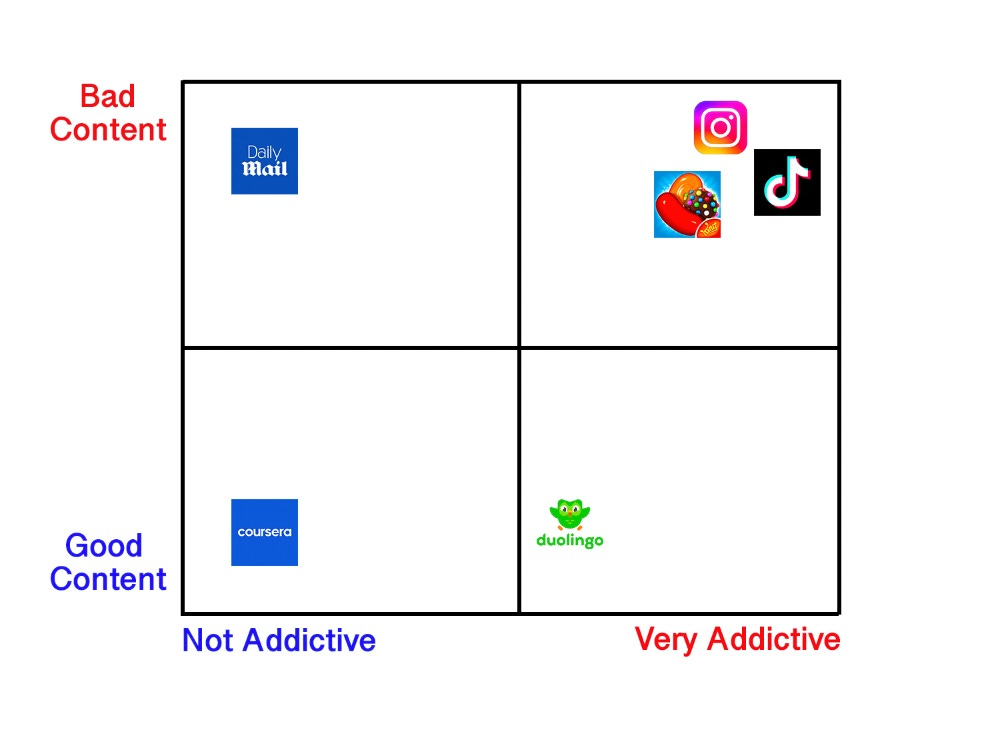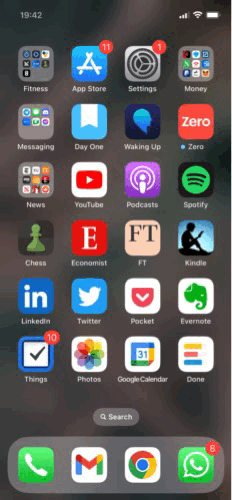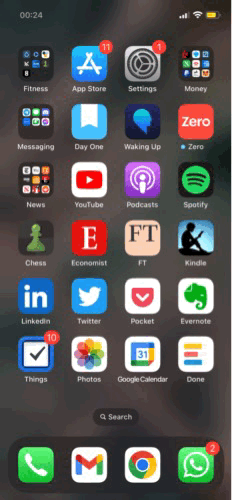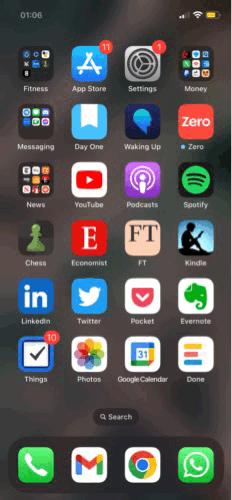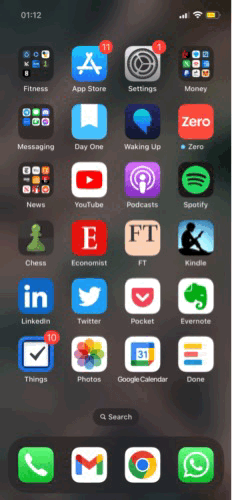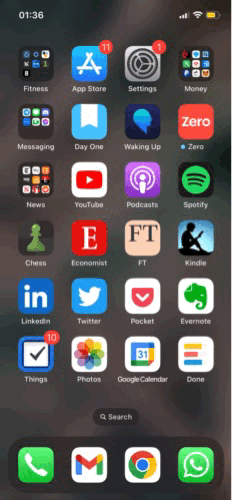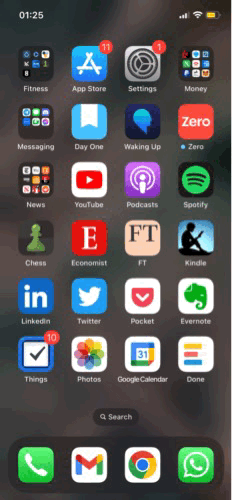Improving Attention with Digital Hygiene
Frameworks and practical design tips for your interactions with tech and content
We are running real-time experiments on our civilisation by introducing widely adopted and not well understood digitally enabled user experiences into our every day lives. It's clear that we are all flying blind and figuring out the best practices and etiquette around these technologies as we go along. The impacts of many of these on our life are not just positive and so our approach to them should be thoughtful. Otherwise, we will fall prey to our tools hijacking our best selves for the benefit of others, rather than them empowering us. This post is dedicated to exploring our changing relationship with our tech and content.
I've been working on a post about the “Mental Arena”, or in other words how to align our remembering, experiencing and aspiring selves to achieve more harmony and satisfaction in life. Part of that post was digital hygiene but it makes more sense to break it out, so here we go.
USER EXPERIENCE DESIGN
In tech we talk a lot about user experience (UX) design. This discipline is primarily focused on making the experience of our product's users positive, meaningful, and satisfying, which can lead to increased engagement, user satisfaction, and loyalty. In TikTok's case the very pursuit of excellent UX can lead us to feel positive dopaminergically and to be satisfied to therefore waste hours of our life on the platform loyally. Even a seemingly positive or benign app like say Duolingo will prod you with notifications to create mindshare for its existence. All these companies understand that the most valuable resource in the the known universe is the attention of humans.
There is nothing wrong with apps using our attention, as long as it is in our best interest for them to do so, which leads us to the first important point of this post: we need to have a personal thoughtful opinion on what our best interest in regards to our digital tools is. Once this is established, we can start creating our own meta UX for all our digital tool interaction, instead of being remote controlled by a haphazard amalgam of some Beijing, Palo Alto, Cupertino, Seattle, London “frankendesign” that may not be aligned with our goals in life.
OUR BEST INTERESTS
What is really important in life? I know this is a seemingly out of place question in this post but it is at the core of all this. Let me venture to answer this in an all encompassing way: the quality and availability of our attention. Whatever it is you have chosen to be your value system or goal in life, if you can't pay attention to it, you are distracted from what is important to you. We sometimes like to distract ourselves purposefully, of course, but that also requires attention. We also sometimes distract ourselves because of the prevailing chatter in our minds, which I will address in my post about the aforementioned “Mental Arena”. But the real tragedy of our time is that many brains are hijacked as a means to create value for some person, brand or corporation. Why did we get here?
Firstly, because we are building and distributing tools faster than ever before without truly understanding the long-term effects of their continuous usage. There is (mostly) no evil masterplan at play here. Well meaning people are by and large designing the product UX of our digital consumer goods. However, they don't have all the answers and in the pursuit of maximising some product metric for their boss or shareholder the second order collateral damage is the long-term mental health of their users.
The second reason is that we are neural networks that are implemented on top of a monkey's motivational system (purposeful oversimplification for rhetorical effect). 95+% of the time this species of monkey has been around, has been spent hunting and gathering. There really has been no time for adaptation to this new reality in civilisation, let alone to a technology that was introduced in 2007 (the iPhone). These digital tools can interact in weird and unintended ways with our monkey motivational system, the same way abundance of calories do. Pathological pursuit of calories (which made sense in a calorie scarce environment) leads to all sorts of physical health problems; pathological pursuit of digital tool usage leads to all sorts of mental problems (with knock on physical effects).
The third reason is that our regulatory systems, which should save us from all this, are just not fit to tackle any of it. As humans we've been around the block and know that industry left to its own devices won't always act in the interest of wider society. That's why countries have historically introduced an alphabet soup of regulatory bodies (FDA, EPA, FTC, SEC, etc) to protect us from the narrow interests of companies. In the case of these new consumer technologies, our regulatory bodies have completely failed us (see the Addendum on regulation at the bottom). The second societal immune response, which usually should come from the media, also failed us by initially uncritically embracing all this new technology and celebrating its founders like celebrities. Now, what most of these margin starved publications do is either report without nuance or with obvious bias. Hence unchecked corporations pump out user experiences faster than anybody can understand their first and second order effects on the human mind.
Knowing all this, we need to take up the responsibility for our digital hygiene ourselves not only for our own sake but also for that of our family and friends. We have to avoid becoming permanently partial attention automatons. Our attention is too valuable to be lost to some intentional or unintentional hacking.
COLLATERAL DAMAGE
Before we come up with a good meta UX for our digital tool usage, let's spend some time considering the impact of unfettered digital interactions. We can split these out into two broad buckets - content and UX.
Your thoughts have immense power over your well-being. While in itself this may be a trivial statement, you should consider the overwhelming evidence for placebo effects. If power of thought can affect molecules and tissues in our body, thereby impacting our health, shouldn't we be just as concerned about our content diet as we are about our food diet? Yes, we should be and probably even more so, because it seems we can think ourselves out of some of the negative side effects of that late night McDonalds binge.
News is content and affects our brains irrespective of what medium it is consumed on. That said in the past news was not running on a 24 hour cycle. CNN first introduced this concept in 1980 (at least in the US). To fill 24 hours with news you sometimes have to elevate things that really aren't that newsworthy, like for instance police car chases (I won't argue with their entertainment value). All of a sudden you are not just watching or reading the news at set times when it's broadcasted (evening news) or delivered (morning newspaper) but there is a constant real-time barrage of it. It turns out that negative news is also much more engaging than positive news. This is clearly a quirk of the monkey motivational system. Our drive to pay attention to negative experiences is there to increase our chances of survival. But we don't only pay more attention to negative news, it also affects us long-term. There are countless studies that have explored this phenomenon. News organisations (knowing our monkey brain wants to hear the negative stuff) can now push infinite content to our connected devices that we check hundred times 24 hours a day. This is certainly a contributor to the erosion of trust for one's fellow citizens as well as the anxiety and depression prevalent in developed countries.
Social media is a special type of content. The tenor of the content is important of course but also the context surrounding it. A negative news article on social media for instance will be affected by comments, likes, its appearance next to your friend's content, its appearance in an endless feed, etc. That means news on social media comes with a whole host of extra baggage that we yet have to understand (I believe it can lead to Overton Mirrors as laid out in this post).
Social content (as in updates from your friends) has a completely different set of issues. There are plenty of studies that have explored this phenomenon as well. In short, being exposed to social content makes you on average more depressed and anxious. While true for adults, this doubly applies to adolescents. Many things can make you sad of course (love ballads?) but the prevalence of social media content and its UX make it much more potent.
The first UX hack responsible for messing with our attention is the notification. I sound like a broken record but there are countless studies that shine a light on how much inattention these cause and how badly they affect our impulse control overall. You may be good at ignoring the notifications as they arise but know that even the seemingly harmless number of unread emails/notifications badges floating on the app icons will create subconscious anxiety.
The next culprit is infinite scroll and auto-play, which create an inescapable abundance of distraction for you to have fun with. These are paired with infinite content and recommender algorithms that become the best at predicting what the monkey wants to see. Thus platforms dish us up the juicy triggering addictive engaging bits. You know how this culminates in a slick app wrapper that hijacks our dopamine system or triggers our amygdala to create longer user sessions to maximise ad revenue. And once we escape, the trusty notification pulls us back in. One two punch...KO.
The vanity metrics (followers, likes, shares, comments) UX introduces a popularity contest to human interaction that leads to inauthentic behaviour. It is true that those are increasingly deemphasised (by for instance Instagram) but the genie is out of the bottle already and people care about these metrics even if they are not in your face. This is well understood so I won't bore you too much with it, however, permit me to elaborate the subjective feelings of this particular monkey when engaging on social media. I frankly dislike some people on social but really like them in person. The incentive systems make them ugly. Furthermore, physical disintermediation (rather than looking someone in their eyes) and anonymity sometimes tempt me to embrace my inner asshole much more than I ever would dream to in meat space. Ancient empathy loops are deactivated on the digital medium and the resulting behaviour by some humans make me generally worried about the future of our civilisation. That's not a good feeling.
It would be remiss of me to not mention that the opposite is also true. The top Youtube comment on most videos will be entertaining or useful. Following some people on Twitter is a source of inspiration and hope. Therefore, it matters how we design our digital experience, so that we can minimise unintentional attention hacking and maximise the positive aspects of abundant content and reach.
CONTENT DIET
The starting point for aligning our best interests with our technology consumption is our content diet. Unfortunately, there is no official nutritional guidance for content that can give us a better sense of what we should be putting into our minds. It is not an easy task to assess content as we do with food, as many of the effects of content can be individual and dependent on our socio-cultural context.
It is worth mentioning, that a content diet is a much larger topic than just what we consume on digital devices. However, the reason I am emphasising digital content consumption is that it often happens to be impulsive. If some door to door salesman or phone sales agent tries to sell me something my guard is up. When I want to chose a movie on Amazon Prime or Netflix I put thought into the selection. I may end up with bad content either way but at least there was more deliberation. Phones are the ultimate Trojan Horse, attached to our brains, always on and connected, ready to provide infinite bad calories for our worst self monkey motivational system. That’s why our guard has to be doubly up for these platforms.
Bad content diets lead to issues with mental health. These can be serious as evidenced by the increase in teenage girl suicides. It isn’t easy for someone who is in a pathological state to step back and assess their content diet. It is outside of the scope of this post to address remedies for those mental states, however, I address those in my “Mental Arena” post.
With that out of the way, let us use a few frameworks to create an intuition for how we should assess content for a good diet.
Positive Versus Negative
A mind that is continuously drowned in negative information is one that will become paranoid and anxious, as we've seen with studies that have explored the effect of negative news on brains. Of course, we want to be informed about the world and bad things happen every day. So we need to strike the right balance between being inspired by the happenings around us and being informed. It is, therefore, advisable to avoid content that is continuously triggering our amygdala. My experience is that a lot of science news fills me with hope for the future and a lot of the current affairs news outlets that are subscription based do a better job at informing rather than just spreading doom and gloom. The latter is the domain of the ad-supported content models, because triggering us will lead to more engagement and time spent on their apps.
Moderate Versus Extreme
It's hard to assess subjectively if something is extreme or not but any content objectively lies on a spectrum from moderate to extreme. For instance, we can say that an opinion categorically in favour or against admitting refugees to a country is at the extremes of the spectrum. An opinion that suggests that context matters, when deciding if someone should be admitted to a country, feels more moderate comparatively. Extreme opinions often lead to militant arguments. In some cases, this is a positive force, for instance when Suffragettes were fighting for the equality of women. But often a nuanced approach to navigating reality and policy options is required, than simplified extreme statements. However, extreme opinions often feel good. They are simple and they allow us to paint the world with a broad brush. The problem is that civilisation will only progress when compromises are made. Therefore consuming extreme content and becoming an extreme person will make us less willing and able to compromise. The ideal content consumption is one across the whole spectrum of opinion on any given issue with a preference to land somewhere in the middle.
Known Versus Unknown
We tend to consume things that continue to strengthen our existing bias and world view. It is actually much harder for our brains to process things that clash with our existing models of reality. Our brains like predicting. For example we predict distances to navigate the world to not bump into things. It's important for our survival to predict right. Predicting wrong is costly and leads usually to learning something new that helps with future predictions (if the prediction error is not fatal). It's similar with our opinions - we form opinions and we'd like to see them validated. Therefore, seeking out content to validate them feels good. Finding content that invalidates them is like bumping against the table. If this happens, we have to learn something new, which is energetically costly and hard to do when mentally exhausted. But it’s the only way to grow. So a superior approach is to try to read things that go against our preconceived notions. This does not mean we have to continuously change our mind, but it means we test our predictions to ensure we navigate the world competently.
People Versus Events Versus Ideas
There is a famous quote by Eleanor Roosevelt: "Poor minds talk about people. Average minds talk about events. Great minds talk about ideas." That is a somewhat cheeky statement but it contains a lot of truth. Our tribal past predisposes us to gossip and news about people. It was very important for the survival and success in a tribe to know what is going on with the chieftain and his family. This is why celebrity news and gossip are such a prevalent content category for many. A general rule of thumb is that consuming content about people when it is negative usually triggers only the worst in us (vengeance, schadenfreude, etc). Good news about people can inspire us, if it doesn't create feelings of envy. Learning about events is better but what we said about news before applies. Spending time consuming ideas, especially when taking into consideration the points above, seems like the most constructive use of our time.
I do not want to arrogantly prescribe to you what content to consume. The previous paragraphs are not comprehensive nor scientific. However, I believe we should be spending a lot more time thinking and talking about the content spectrum in more sophisticated ways. We should have a lot more research dollars going into this given that distribution of content has wholly changed with the advent of ever connected personal computing devices. In the meantime, though, it is useful to run this exercise yourself and challenge your content consumption behaviour. Once you have determined what your best self requires, you can create the right user experience to safe guard your mind and attain a better quality of attention.
FRICTION UX
Safeguarding our brain and thereby our attention by consuming quality content is the goal. This means we need to design the UX of our digital devices to help with that. Absent minded humans pick up their phones impulsively dozens of times a day and tap on the comfort food equivalent of an app on their home screens (Instagram, TikTok, Youtube, etc). Even if one ends up consuming high-quality content on those, it can lead to a massive time-wasting exercise, which leads to stress or procrastination. A way to avoid these type of impulsive transgressions of ones better self agenda, is to introduce friction.
Friction in UX is usually to be avoided at all costs, as product designers want users to get to do the thing they want to do most efficiently. In the cases we've described, however, the user’s worst self is driving decision making to get a quick fix with various knock on effects. Introducing friction allows for impulsive behaviour to be second guessed. Daniel Kahneman in his book "Thinking Fast and Slow" introduced the notion of System 1 and System 2 thinking. System 1 operates automatically and quickly, with little or no effort and no sense of voluntary control. System 2 allocates attention to the effortful mental activities that demand it, including complex computations. You may have zoned out while reading this, as you're in System 1 mode but if I now ask you to divide 65 by 13 your pupils dilate, your heartbeat slightly increases and you shift into Systems 2 thinking. So friction allows for our System 2 to kick in and save us from bad app and content consumption!
App Selection
Knowing what content is good for you and what content isn't, allows you to stack rank apps more broadly based on the prevalence of said content.
Some apps allow you to customise your experience within (e.g. who you follow on Twitter) while others are as is (e.g. Daily Mail app). So the customisable apps depending on who you follow may rank differently based how you adjust your settings.
Assessing the addictiveness of apps is subjective but if you tend to open it out of affect and regret the minutes spent on it, I'd place it in the addictive bucket. There can be addictive apps like say brain training games or Duolingo that may have good content.
As a general rule, you should be suspicious of infinite scroll UX and recommender algorithms that do too good a job of hijacking your motivational system.
So now that you have your app categories classification you can decide whether you should delete them from your phone all together or create friction. If you tend to be bad with impulse control it may be advisable to get rid of all addictive & bad content apps.
App Placement
The home screen is prime real-estate. More specifically the easy to reach by your thumb bottom right corner (if you are right handed).
Creating friction can be as easy as moving an app into the top left corner. The next step would be to put it into a folder on the home screen to introduce an extra tap. Ideally you don't want to have any time waster apps on your Home Screen to begin with. Consider moving an app to page two, then to page two into a folder, page three... and so on.
A cool feature on the iPhone is also that you can hide a page all together. If you touch and hold your screen to go into edit mode, you'll see a pill shaped button popping up at the bottom of your home screen. If you tap it you can tick some of your pages to hide them away.
But how do you get to the apps on page 2 then once it's hidden? Again on iPhone swipe down and use the search to type the app name to find and open it. These are all moments of friction that allow you to check whether this behaviour is really favourable.
A pro tip on iOS to go into your settings "Siri & Search" and to turn off "Show Suggestions" and "Show Recents". This way if you swipe down to search you'll get a clean UX and no temptations to lead you astray.
States
There are a few more advanced ways to customise your app setup. On iPhone for instance if you search for "focus" you can setup a state. It also allows you to have different notification settings. Spending some time to understand what focus settings your phone allows you to customise, is time well spent.
I have a normal, work and wind down state. Work has no time wasters within reach. Wind down has good time wasters (Kindle, Audible, etc) available but no communication apps. Here is a video on how to do this on iPhone. One thing the video doesn't mention is that you can switch any page of your iPhone screens to your Home Screen for that focus and hide all other screens to create a completely different UX. Play around with this, so you can create a better UX for your different activity states.
Notifications
As discussed notifications are a great way for our attention to be hijacked. You should seriously consider which apps you want to allow to do that. Notifications come in different "sizes". The most vicious is the push notification - inherently built to interrupt. The next level down is a lock screen notification, which can interrupt by drawing your attention while locked. Less intrusive yet is a notification centre notification. This means the notification will be in an inbox for you to review once you unlock your phone. This feels like a good compromise as it doesn’t interrupt. While the notification centre gives you a preview of the content of the notification, the final notification level, the app badge, is just a red number on the app to create awareness that some notification is waiting for you.
A way to think about this is that it makes sense for practical apps like banking, Uber or food delivery apps to interrupt to notify you, because they mostly do so as you are using the service. Hence, a push notification here is actually essential.
Most social, gaming and news apps are on a mission to distract you from what you are doing to monetise your attention. It's advisable to limit those at best to the notification centre. This way at least the notification won't compel you to pick up the phone.
Communication apps are tricky as they are very dependent on who the person trying to reach you is, the context of their message and your state. I have different settings depending on which state I'm in, which are tied to the focuses above. In wind down, everything is turned off.
I never have any email or work chat notifications turned on, as it's an activity that I like to do in regular but deliberate chunks rather than having permanent partial attention in the present due to emails or PMs being fired at me.
App badges with red numbers all over my home screen trigger my brain, so they are turned off for everything but Whatsapp, my to-do list app, the App Store (to show me if I need to update any of my apps) and Systems settings (again for updates).
I found the best way for me to figure out what I really need is to turn off everything and then slowly reintroduce things as I identify their practical need in my life. Believe me the world won’t end when you turn off all notifications. Try it!
Helper Apps
There are a few apps that can help you with creating friction. The inbuilt screen time apps usually allow you to set daily caps for app usage. I've done this by default for all time waster apps. They allow you to extend the cap by notifying you that you have reached it and thereby make you aware that you have probably wasted enough time that day.
Another great helper app category are the ones that stop you from opening time wasters. The app One Sec creates a 3 second animation you need to watch before you can open say Instagram. At the end of the animation it asks if you are sure if you want to really really open it, while also giving you stats about your last use. Your System 2 this way gets a chance to save you. This has been one of the most effective ways to stop me from opening Instagram & TikTok.
There are many other apps in this category from blocking apps at certain times to creating more awareness about my usage through reports etc. Here is a list of a few useful ones.
Laptops
All the advice above was very phone centric but by and large can be applied to laptops too. The main interface to time wasting on your laptop is the browser. The equivalent of app selection above is website selection.
For app placement I suggest a bit of a hack. There are many good browsers out there. I run multiple on my laptop at the same time. On the main browser I'm not logged into social sites or any of my content subscriptions. Those are all on a different browser, which means I will have to open that to "waste time". This creates enough friction for System 2 to check me.
Tab management is a big deal in your browser. Modern browsers have folder functions which allow you to throw all the tabs you don't need into a folder so they don't distract you (check out my fave browser SigmaOS). You can also copy paste tabs that would otherwise distract you into a "time waster browser". Add the tab there and close the browser. This way you have not lost the link but are also not distracted by it.
The only notifications my browser pings me for are my calendar. I don't think any other notification is required. The same logic that applies to the phone is also valid for laptops (I've turned off Slack and Gmail notifications to batch process those during set times of the day).
There are many apps to help with focus states or website tracking and blocking etc. on desktop as well.
This may be a bit overkill but for writing I have a separate laptop. I've installed nothing but Evernote on it, not even a browser. This helps me with deep focus as it's literally just a modern day type writer (which by they way also exist if you want to take this to the next level).
CLOSING THOUGHTS
For me to prescribe what content and apps you should be consuming feels self-important. This is why I have solely shared my personal musings and frameworks for how one could approach the subject of designing a better UX to safeguard the quality and extent of attention available for your own pursuits. In itself even seemingly self-guided pursuits are the result of some meta-programming of external forces - memes, friends, parents, society. The way those forces work on us, however, seems somewhat more straightforward (unless the programming was made when we were children). If people want to waste my time or lead me astray with some scheme in the real world it feels a lot easier to spot it and resist it. The sinister aspect of the digital hijacking is that it is conducted through the ultimate Trojan Horse vehicles - my phone and laptop. I'm using these continuously and absentmindedly often with my guard down.
I would therefore respectfully advise you to, at the very least, use this post as a trigger to think about your own behaviour. I revisit my usage on a regular basis, because regressions are common. You won't regret thoughtfully spending some time questioning your digital tool interactions to see if introducing some UX friction and filtering some content will aid your quality and availability of attention. Life is so short, it would be a shame to let any of it pass us by unintentionally.
ADDENDUM
Some half-baked thoughts on regulation that I will expand on in a different post:
Why don't we have PG ratings for apps in the stores?
Cigarette packs have warning labels. Why is there no 2 second interstitial screen every time you open Instagram warning about its potential negative mental health effects that are well established especially for teenage girls?
Why is any notification turned on by default when we buy our phone? They should all be turned off and only get enabled with triple opt-in.
On AI - why don't we create a cross functional committee consisting of company, research and government representatives that review any model (in a reasonable time frame) before it is released to the wider public? Surely this makes more sense than a 6 month pause or individual lobbying efforts by the big players.
There are plenty more pragmatic suggestions out there. As you can tell these examples are not even that creative. They just reuse ideas regulators have used in other contexts. Why tech has somehow gotten away without any of the best practices used in other domains being applied to them is a mystery to me. It's either great lobbying or incompetence on the regulator side (probably both). It is fairly practical to introduce some of the above suggestions to create some more friction into the UX of our daily digital experience. An unintentional example of introducing friction is the somewhat stupid GDPR cookie opt-in policies (yes, they are maddening). Arguably that friction is unnecessary but it is a precedent for us to create better targeted and useful friction in the future.


